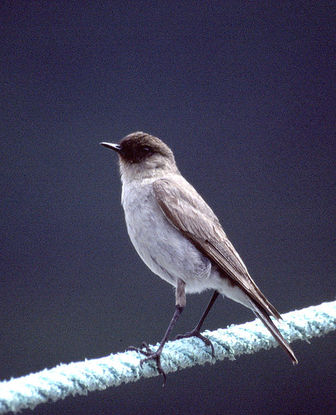Dark-faced Ground-Tyrant
It is 16 cm long with the male being slightly larger than the female. Like other ground-tyrants, it has long legs and an upright posture. The plumage is mainly dark grey-brown above and pale greyish below with a dark brown crown and a blackish face. The rump and tail are black with white outer tail-feathers. The legs and bill are black. Birds on the Falkland Islands are larger and greyer than those in mainland South America .

Original source: YannPermission(Reusing this file)This image, which was originally posted to Flickr.com, was uploaded to Commons using Flickr upload bot on 19:48, 25 March 2010 (UTC) by Snowmanradio (talk). On that date it was licensed under the license below.This file is licensed under the Creative Commons Attribution 2.0 Generic license.You are free:to share – to copy, distribute and transmit the work
Author: YannPermission(Reusing this file)This image, which was originally posted to Flickr.com, was uploaded to Commons using Flickr upload bot on 19:48, 25 March 2010 (UTC) by Snowmanradio (talk). On that date it was licensed under the license below.This file is licensed under the Creative Commons Attribution 2.0 Generic license.You are free:to share – to copy, distribute and transmit the work
The Dark-faced Ground-Tyrant is classified as Least Concern. Does not qualify for a more at risk category. Widespread and abundant taxa are included in this category.
The Dark-faced Ground-tyrant (Muscisaxicola maclovianus) is a small passerine bird belonging to the tyrant flycatcher family. It is a ground-dwelling bird of southern South America which feeds on small invertebrates such as flies and moths. More
View all pictures of Dark-faced Ground-tyrant View all pictures of Dark-faced Ground-tyrant show section External Links (0) We currently have no external links for this species. More
Family : Tyrannidae
Genus : Muscisaxicola
Species : maclovianus
Authority : (Garnot, 1829)
